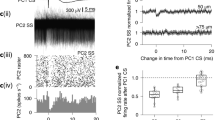Abstract
THE principal neurones of the vertebrate sympathetic ganglia usually respond to suitable preganglionic stimuli with three types of temporally distinguishable postsynaptic potential (PSPs) in the following sequence: an initial excitatory one (fast EPSP), a slow inhibitory one (slow IPSP) and a slow excitatory one (slow EPSP)1,2. These three responses can also be distinguished pharmacologically: the fast EPSP is mediated by a nicotinic acetylcholine receptor, and the slow EPSP by a muscarinic acetylcholine receptor. The synaptic pathway of the slow IPSP includes intervening adrenergic cells (called “SIF” cells3) which release a catecholamine transmitter (identified as dopamine in the case of rabbbit4,5), in response to the muscarinic action of acetylcholine, and in turn hyperpolarise the ganglion cells.
This is a preview of subscription content, access via your institution
Access options
Subscribe to this journal
Receive 51 print issues and online access
$199.00 per year
only $3.90 per issue
Buy this article
- Purchase on Springer Link
- Instant access to full article PDF
Prices may be subject to local taxes which are calculated during checkout
Similar content being viewed by others
References
Eccles, R. M. & Libet, B. J. Physiol., Lond. 157, 484–503 (1961).
Libet, B. Fedn Proc. 29, 1945–1956 (1970).
Eränkö, O. & Härkönen, M. Acta physiol. scand. 58, 285–286 (1963).
Libet, B. & Owman, Ch., J. Physiol., Lond. 237, 635–662 (1974).
Libet, B. Structure and Function of the SIF Cells (ed. Eränkö, O.) 163–177 (US Government Printing Office, Washington DC, 1976).
Libet, B. & Tosaka, T. Proc. natn. Acad. Sci. U.S.A. 67, 667–673 (1970).
Libet, B., Kobayashi, H. & Tanaka, T. Nature 258, 155–157 (1975).
Kalix, P., McAfee, D., Schorderet, M. & Greengard, P. J. Pharmac. exp. Ther. 188, 676–687 (1974).
Aleman, V., Bayon, A. & Molina, J. Adv. behav. Biol. 10, 115–124 (1974).
Libet, B. & Tosaka, T. J. Neurophysiol. 32, 43–50 (1969).
Shinnick-Gallagher, P., Williams, B. J. & Gallagher, J. P. Neurosci. Abstr. 2, 1152 (1976).
Hsu, S. Y. Fedn Proc. 36, 319 (1977).
McAfee, D. & Greengard, P. Science 171, 1156–1158 (1971).
Dun, N. J. Fedn Proc. 36, 318 (1977).
Libet, B. J. Neurophysiol. 30, 494–514 (1967).
Volle, R. L. J. Pharmac. exp. Ther. 136, 68–74 (1961).
McIssac, R. J. J. Pharmac. exp. Ther. 200, 107–116 (1977); Fedn Proc. 36, 976 (1977).
Greengard, P. Nature 260, 101–108 (1976).
Dun, N. J., Kaibara, K. & Karczmar, A. G. Science 197, 778–780 (1977).
Author information
Authors and Affiliations
Rights and permissions
About this article
Cite this article
KOBAYASHI, H., HASHIGUCHI, T. & USHIYAMA, N. Postsynaptic modulation of excitatory process in sympathetic ganglia by cyclic AMP. Nature 271, 268–270 (1978). https://doi.org/10.1038/271268a0
Received:
Accepted:
Published:
Issue Date:
DOI: https://doi.org/10.1038/271268a0
This article is cited by
-
Adrenaline inhibits muscarinic transmission in bullfrog sympathetic ganglia
Pflügers Archiv - European Journal of Physiology (1989)
-
Role of cAMP in dopamine effect on background and glutamate-induced neuronal activity in rat neostriatum
Neurophysiology (1986)
-
Sustained rise in ACh sensitivity of a sympathetic ganglion cell induced by postsynaptic electrical activities
Nature (1983)
Comments
By submitting a comment you agree to abide by our Terms and Community Guidelines. If you find something abusive or that does not comply with our terms or guidelines please flag it as inappropriate.



